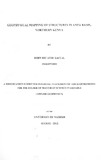| dc.description.abstract | The study area is located at the Anza basin. It lies between latitudes of 380 05/ E& 380 25/ E and
longitudes of 20 00/ N & 20 21/ N and covered an area of 1,687.5 km2. The area is important due
to its thick sedimentary deposits that may be potential hydrocarbon sources. The study was
initiated by processing and analyzing aeromagnetic data through specialized computer software
(Geosoft Oasis Montaj V.6.4.2, 2007) and software EUL, by G.R.J. Copper of Witwatersrand
University, South Africa for the profile data.
The aeromagnetic data were plotted to produce total aeromagnetic intensity map and then
reducing the total aeromagnetic intensity field to the north magnetic pole (RTP). The resultant
maps of (RTP) and (TMI) shows the causative source bodies trending NW-SE, NS and NE-SW,
constituting magnetic highs and lows.
Different interpretation techniques were applied to aeromagnetic data including regionalresidual
separation such as upward continuation, vertical derivative method for enhancing
shallow bodies followed by depth determination along magnetic grid and profiles using 3D and
2D Euler de-convolution method respectively, and analytic signal method, to delineate the
subsurface structures and to estimate the magnetic sources depth of the study area.
This study intended to delineate and identify the possible subsurface structure of the area that
may assist in locating hydrocarbon prospects by applying magnetic method as a tool for
mapping.
Results of 3D Euler de-convolution technique estimated the maximum depth in the study area to
be about 7.0 km in southeastern part of the study area, where the depth varies along the graben
and registered the average depth of 3.0 km. The lava flow bodies registered the shallowest depth
of about 0.4 to 1.0 km in different parts
In addition, the 2D Euler solutions of (19) aeromagnetic profiles in form of flight lines suggested
that; the study area is structurally controlled and was affected by two tectonic events represented
by; major striking NW-SE trends associated to Anza Graben movement and NE-SW trend
attributed to set of fractures related to Miocene Kenya Rift System
controlled the volcanic lavas that rested within the sedimentary sequence in the study area.
The structural gaps and shield volcanic doming structures that penetrated and covered the older
sedimentary sequence identified by the 2D Euler solution along the profiles as well as deep
basins outline by 3D Euler solution, are the most promising potential areas for hydrocarbon
accumulation in the study area. | en |

